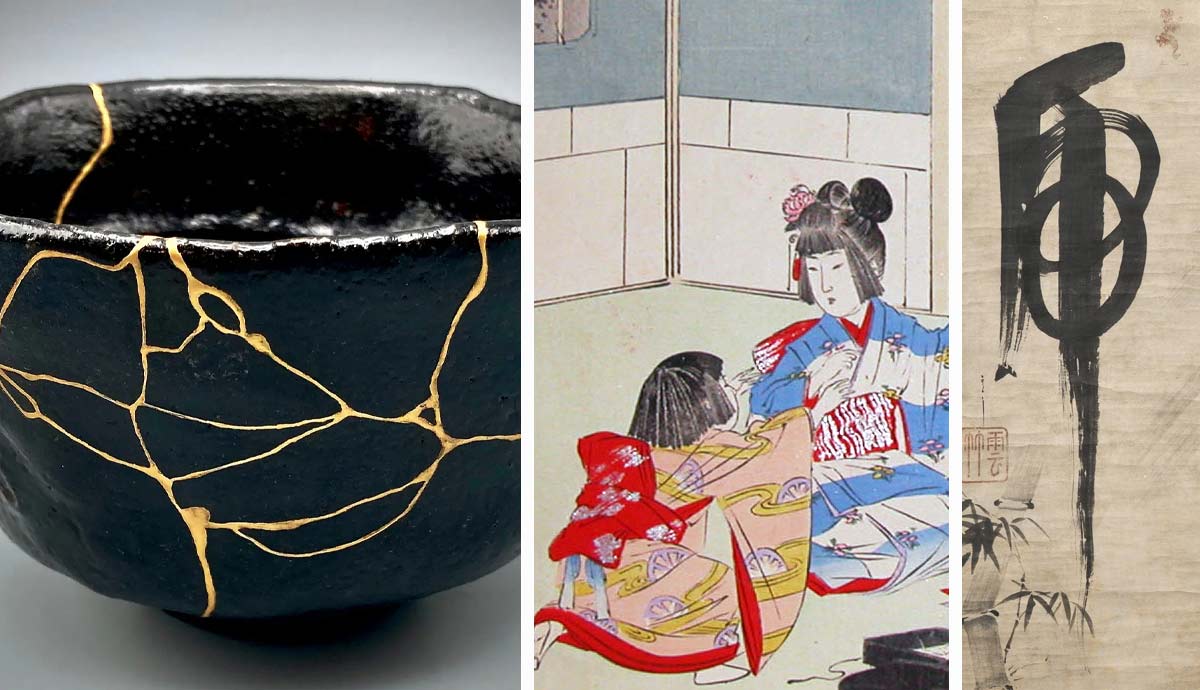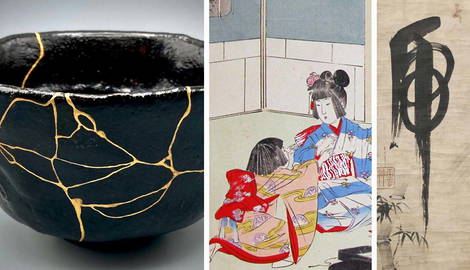
Japanese art has a millennial-long history. Based on the principles of simplicity, hard work, concentration, and contemplation, it inspired artists both at home and in other parts of the world. In the 19th century, when Japan became available for Western travelers, the unseen-before types and forms of art flooded European markets and collections, inspiring a revolution in visual language. Read on to learn more about 10 distinctively Japanese forms of art that still exist and are popular today.
1. Ukiyo-e: The Most Famous Japanese Form of Art

Ukiyo-e, or the Japanese woodblock print, is perhaps the most famous and easily recognizable form of Japanese art to Westerners. After Japan finally opened its borders to the rest of the world in the 19th century, ukiyo-e prints flooded European markets and inspired generations of artists, including Vincent van Gogh, Edgar Degas, the Impressionists, and many more artists.
Ukiyo-e as an art form emerged in the 17th century and mostly represented the leisure and luxuries available to the wealthy class. Originally, these were monochrome images of beautiful women, artisans at work, or kimono designs, printed with a single carved block. However, just a century later, artists learned to use up to dozens of different blocks to add more colors and patterns to each image. Ukiyo-e was a highly commercialized art form, with images reprinted many times and sold in thousands. The subject matter of such prints was diverse and spanned from peaceful landscapes to bizarre erotic scenes.
2. Surimono

Surimono is a particular sub-genre of ukiyo-e that was made to order. Unlike the general ukiyo-e, surimono prints were exclusive to the commissioner and thus did not have to rely on popular tastes. For that reason, surimono works were often more experimental and complex in their nature and related to specific events or personal achievements. Such works often featured poetry as they were intended for affluent and educated audiences. Many surimono prints were commissioned by poets’ societies and groups to celebrate particularly inspiring poetic works. Due to their exclusive nature, surimono prints barely reached Western audiences, and for a while, their complex techniques, subtle colors, and complex compositions were missing in the discourse on Japanese painting styles.
3. Nihonga

Nihonga is a painting style literally translated as “Japanese painting.” Traditional nihonga works are created on silk, wood, paper, or plaster with ink and mineral pigments. The pigments are fixed with a gel-like substance extracted from fish and animal bones. Apart from pigments and animal glue, artists often used gold and silver leaf for backgrounds or detailing of their works. The subject matter relies on traditional Japanese customs, history scenes, nature, and other distinctively Japanese scenes.
The opposite of Nihonga’s distinctively Japanese stylistics is Yōga, a painting style that relied on Western techniques, motifs, and materials like oil paint. Initially, the two styles were presented as antithesis to each other but, over time, fused in synthetic works. Although nihonga painting existed for centuries, the term for it originated only in the 1870s, with the newly occurring need for distinction between Japanese and Western painting.
4. Shikki

Shikki is a type of lacquerware, wooden objects painted and coated with layers of resin harvested from trees. It is an ancient tradition that was in use already in 7,000 BCE and still lives on today. Archaeologists often find shikki works that are several thousand years old but still retain the brightness and vividness of their colors. Contemporary masters still rely on ancient recipes and techniques that are impossible to imitate with artificial materials of the 21st century.
The Shikki technique was used for practical objects like furniture, pots, bowls, and decorations alike. For centuries, the Japanese cultivated their lacquer trees and maintained continuous production of lacquerware. With proper care and occasional recoating, shikki pieces can last centuries despite continuous practical use.
5. Kintsugi

In many cultures, broken pottery is seen as a bad omen that needs to be removed from home as soon as possible. That is not the case with Japanese culture, as local masters embraced imperfection and repair as part of objects’ lifespan and history. Kintsugi masters fix broken pieces of pottery with urushi lacquer (the same that is used for shikki lacquerware) and powdered metals like gold or silver to deliberately highlight the seams and cracks instead of hiding them.
The use of the kintsugi technique relates to the Japanese aesthetic philosophy of wabi-sabi—the acceptance of impermanence and imperfection and prioritizing inner integrity over superficial flamboyance.
6. Ikebana

The art of Japanese flower arrangement, known as ikebana, was originally used for temple decorations, inviting gods into spaces arranged for them. Some viewers wrongly explain ikebana as an imitation of nature; in fact, it does not attempt to mimic the natural plant growth but rather arranges the plants in spaces for contemplation and appreciation. Traditional ikebana compositions are based around a single central element and follow a clear set of rules concerning the proportions of flowers and vases used. Many contemporary masters, however, are eager to experiment with form and material, incorporating plastic, metal, stone, and other unconventional materials into flower arrangements.
7. Shodo

Shodo is a form of Japanese calligraphy. Originally, it used the Chinese language and traditions of Chinese calligraphy but, by the 7th century, developed into its own form. The art of calligraphy requires concentration and mastery and is often treated as a form of meditation.
In the 19th century, artists inspired by Western forms of art made an attempt to exclude calligraphy from the list of art forms altogether, categorizing it as solely an instrument of language. One of the most radical opponents of calligraphy, Koyama Shōtarō stated that in painting, an artist could easily correct a mistake or incorporate it into the composition, while in calligraphy, every flaw turned fatal. Thus, in Koyama’s view, calligraphy was an outdated art form that did not encourage experimentation.
8. Origami

In the West, the ancient Japanese tradition of paper folding, or origami, is often dismissed as an easy hobby. However, it has ancient origins relating to the religious tradition of wrapping temple offerings on paper. Later, it evolved into a recreational and decorative practice for the elites to demonstrate their skills and knowledge.
For centuries, origami has been developing and incorporating new techniques. One of the novelties from the 1900s was wet-folding—origami from dampened paper. By wetting the surface, origami masters made the paper easier to fold and form, turning it into a sculptural material. Unlike traditional origami which relies on geometric forms and angles, wet-folding allows for softer curved forms. In the 1950s, origami master Akira Yoshizawa developed a system of diagrams used to record origami-making processes of any complexity, thus making the art more accessible and easy to study.
9. Shibayama

Shibayama is a complex art form of arranging high-relief carved fragments of mother-of-pearl, ivory, bone, and precious stone into compositions and coating them with lacquer. The name for the art type came from the Shibayama family, who developed the centuries-old tradition of carving into a more complex and refined form. Shibayama works were among the main sources of income for Japan in 19th-century Europe, where collectors and art lovers were obsessed with them.
Shibayama works are fragile and require complex restoration in case of damage. Unfortunately, today the list of skilled masters capable of correctly restoring antique museum-quality works is severely limited. The main reason for it, as with many traditional techniques, is that it has lost its past appeal due to the suffocating presence of mass-produced works.
10. Tojiki

Tojiki is a generalized name for several Japanese pottery and porcelain techniques. The earliest preserved examples of Japanese pottery date back to 15,000 BCE. One of the main factors that contributed to the development of pottery techniques in Japan was the popularity of tea culture and ceremonies.
Japanese ceramics take different forms, but the most prominent and distinctive of them is the one that embraces imperfections, irregular shapes, simple forms, and uneven glazing. For instance, ceramists working with raku ware reject the use of pottery wheels and shape their bowls and cups with their hands, deliberately leaving unevenly thin walls and asymmetric contours. Perfectly formed and painted porcelain vessels were usually made referencing Chinese tradition.










